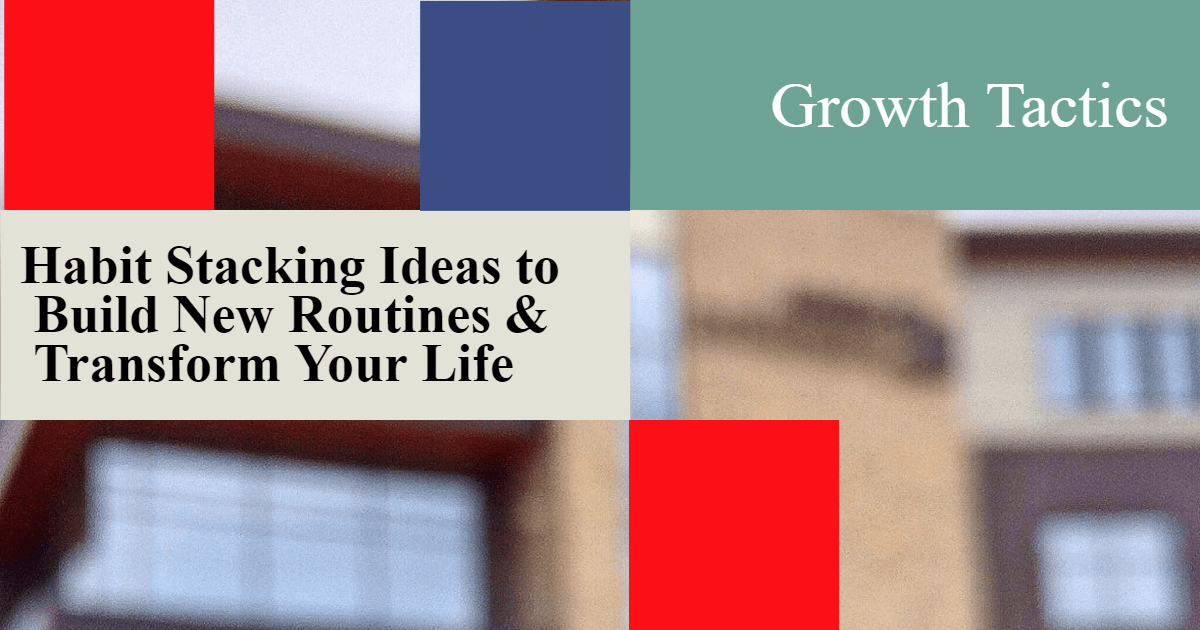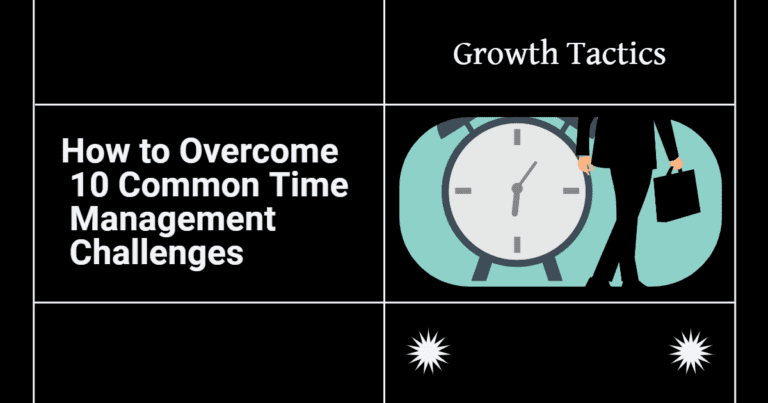Habit stacking is a technique for building new habits and routines by “anchoring” them to existing habits. The idea is to stack a new habit onto an old one so that the new behavior becomes associated with the existing cue and reward.
For example, let’s say you want to start a daily meditation practice but find it hard to motivate yourself to do it consistently. You could stack the new habit of meditating for 10 minutes onto your existing morning routine of making coffee. So your new routine would be:
- Wake up
- Make morning coffee (existing habit)
- Meditate for 10 minutes while drinking coffee (new habit)
The cue is your morning coffee, which you already do regularly. By pairing the new behavior with an existing habit, it becomes much easier to remember and turn it into an automatic routine.
In this article, we’ll provide some habit stacking ideas to really push you toward success.
Jump To Section
The Science Behind Habit Stacking
Research shows that habit stacking utilizes key principles of habit formation and psychology to make it easier to build new routines. The concept is based on the cue-routine-reward loop that underpins how habits form. Certain cues or triggers spark an associated routine or behavior, which is rewarded through a feeling of satisfaction. Habit stacking relies on “anchoring” a new routine to an existing habit that already has an ingrained cue-routine-reward loop.
For example, let’s say you want to establish a new habit of doing 10 pushups each morning. You’re already in the habit of brushing your teeth when you wake up. By mentally linking the new routine of 10 pushups to the existing cue of brushing your teeth, it becomes much easier to remember to do the pushups. As you repeat this stacked sequence day after day, eventually it becomes automatic.
The psychology of anchoring a new behavior to an old one utilizes the power of behavioral conditioning. Your brain starts to associate the already familiar cue of tooth brushing with the new routine of pushups through repeated pairing. Research on habit formation shows that new behaviors are most likely to stick when anchored to existing habitual cues that happen at the same time and place daily.
Habit Stacking vs. Trying to Build Habits from Scratch
The key difference between habit stacking and trying to build habits from scratch is that habit stacking relies on linking a new habit to an existing habit while trying to build a new habit from scratch requires creating a brand-new routine.
Creating habits from scratch can be very difficult because you have to build new triggers and remember to do the new behavior. Without an existing habit to link it to, a new habit has no natural reminder or cue to do it consistently.
Over time, this creates a chain reaction where the first habit cues the second one. Rather than having to remember and motivate yourself to do the new habit, it happens automatically after the first habit. This makes habit stacking much easier than trying to build a standalone habit.
By relying on existing routines, habit stacking removes the friction and effort needed to maintain new habits long enough for them to stick. Research shows it takes an average of 66 days to cement a new habit. Habit stacking helps you more easily get through those crucial first weeks by turning an existing habit into the trigger.
Step-by-Step Guide to Stack a New Habit
The key to successfully stacking a new habit is to follow these steps:
Identify an Existing Habit as Your Cue
Look at your current daily habits and choose one that you already do consistently without much effort. This will serve as the cue to remind you to stack your new habit. For example, if you brush your teeth twice a day, you can use that as your habit stack cue.
Choose a Simple New Habit to Add
Don’t try to add too much too soon. Select a small, easy new habit that takes less than 5 minutes to complete. Good starter habits include doing 10 pushups, drinking a glass of water, stretching for a few minutes, meditating for 1 minute, or reading 1 page from a book.
Be Consistent with Your Habit Stack
Perform your new habit right after your existing habit every time for at least a month. Consistency is key in order for your new habit to stick. If you only do it occasionally, it likely won’t become automatic.
Gradually Increase the New Habit
Once your starter habit feels easy and automatic, you can make it slightly bigger. For example, increase your pushups from 10 to 15 or your reading from 1 page to 2 pages. Gradually build up your new habit over time.
Habit Stacking for Morning Routines
Waking up early and starting your day off right with a solid morning routine can set the tone for a productive, positive day. Habit stacking is one of the easiest ways to build a rock-solid morning routine.
For example, let’s say your current morning habit is to wake up, go to the bathroom, and brush your teeth. You want to add some more beneficial habits like making your bed, drinking a glass of water, and doing 10 pushups.
Instead of trying to force yourself to wake up and suddenly do all those new things, stack them onto your existing habits. As soon as you finish brushing your teeth, immediately make your bed. Once your bed is made, do 10 pushups. After pushups, go and drink a glass of water. By linking these new behaviors to an existing habit you already do, it becomes much easier to build a new routine.
Some other examples of habits you can stack onto morning basics like waking up, using the bathroom, and brushing your teeth include:
- Make bed
- Get dressed in workout clothes
- Put on running shoes
- Do 10 pushups
- Drink a glass of water
- Take vitamins
- Make a green smoothie
- Listen to a motivational podcast
- Read 10 pages
- Journal for 10 minutes
- Practice gratitude
- Stretch for 5 minutes
The key is to start small by adding just 1 new tiny habit at a time and build up the routine gradually. Habit stacking leverages the power of your existing habits to seamlessly build new positive routines.
Habit Stacking for Evening Routines
Creating a relaxing evening routine is crucial for getting better sleep and starting the next day feeling refreshed. Habit stacking is an effective way to build wind-down habits before bed and incorporate self-care into your nights.
Some examples of habits you can stack onto your evening wind-down routine include:
-
After brushing your teeth, apply moisturizer or face mask. The cue of brushing teeth reminds you to also practice skin care.
-
After changing into pajamas, make a cup of herbal tea. Changing clothes cues you to also make a relaxing tea.
-
After dinner, stretch for 10 minutes. Eating dinner reminds you to loosen up muscles before bed.
-
After turning off the screens, read for 15 minutes. Powering down devices cues reading time.
-
After locking the doors, do 5 minutes of meditation. Locking up cues your mind it’s time to unwind.
-
After taking medication, write in a gratitude journal. Taking pills reminds you to reflect on the day.
Habit stacking works for evening routines because you tie a new calming habit to an existing cue you already do before bed. This helps the new habit become automatic. The key is to start small – stack just 1 new habit at a time onto your wind-down routine until it sticks. Over time, your evenings will feel more restful.
Habit Stacking for Health & Fitness
Habit stacking is a great way to build healthy routines into your day. Here are some ideas for health and fitness habit stacks:
Exercise
- After you wake up, put on your workout clothes and shoes before anything else. Once dressed, do 10 push-ups or squats.
- Stack a 10-minute YouTube workout onto your morning coffee routine. After brewing your coffee, do the quick workout video before enjoying your coffee.
- Take a short walk outside after every meal. The transition from eating to walking can help signal your brain it’s time for activity.
Drinking Water
- Drink a glass of water immediately after waking up in the morning.
- Drink a glass of water after finishing a task at work. The water break provides a natural transition between tasks.
- Drink a glass of water before each meal to aid digestion.
Food Tracking
- Take a photo of your food before eating any meal. Once you’ve taken the photo, log your meal in a food-tracking app.
- Weigh or measure food portions before cooking or plating meals. Logging the portions ahead of time makes tracking easier.
- Log your food as soon as you’re done eating. Using your plate as a visual cue can make food journaling seamless.
The key is to stack a small health habit onto an existing habit you already do daily. This linking creates a natural trigger that can remind you and create an automatic healthy routine over time. Start small, be consistent, and build up your health stacks gradually.
Habit Stacking for Productivity
Habit stacking can be a game-changer when it comes to building productivity habits. Many of us want to write more, read daily, learn new skills, or improve our planning and time management. But taking on big goals like “write a book” or “read 30 minutes every day” can feel overwhelming.
That’s where habit stacking shines. By tackling small, specific habits and stacking them onto existing routines, you can make consistent progress. Some ideas:
-
Writing: Add “write for 10 minutes” after your morning coffee. Use a cue like brewing your coffee as the trigger to sit down and write. Or write for 5 minutes during your lunch break. Stack it onto eating lunch.
-
Reading: Keep a book on your nightstand and read for 10-15 minutes before bed. Stack reading onto your bedtime routine. Or read for 10 minutes when you first wake up, before checking your phone.
-
Learning: Choose a new skill to learn and practice it for 10 minutes per day after dinner. Stack your learning onto clearing the table after eating.
-
Planning: Spend 5 minutes reviewing your calendar and to-do list while drinking your morning coffee. Stack planning onto your morning routine.
Start small with these kinds of habits, like “read for 10 minutes” or “practice Spanish for 5 minutes.” Tiny habits are easier to stick to. And they can add up to big changes over time. The key is consistency. Habit stack them onto existing routines and you’ll actually follow through.
Habit Stacking to Break Bad Habits
One effective way to break bad habits is by using habit stacking to replace them with better habits. The key is to stack an opposite habit that makes the bad habit impossible.
For example, let’s say you want to stop mindlessly snacking in front of the TV. A habit you could stack is to go for a short walk right after dinner. By stacking a walk onto your evening routine, you remove the cue (sitting on the couch) that leads to snacking.
Another example is stopping smartphone use before bed. Instead of scrolling in bed, you could stack the habit of reading a book or listening to calm music. This replaces the bad habit with a relaxing new cue.
The trick is to identify the cue that triggers your bad habit, then insert a new routine to interrupt the pattern. As James Clear says in Atomic Habits, stack an “instant gratification habit” with a “long-term satisfaction habit.” The instant payoff helps you stay consistent, while the longer-term results keep you motivated.
Habit stacking works well for quitting addictions too. Let’s say you want to stop smoking. You could stack chewing gum or eat a healthy snack when you get a cigarette craving. This new cue disrupts the smoking habit. Over time, the cravings fade as you reinforce the new routine.
The key to habit stacking is being intentional about inserting a replacement routine. Don’t try to simply stop doing the bad habit. Stack a new cue that makes the old habit impossible. This builds a sustainable new routine so the bad habit never returns.
Common Mistakes to Avoid
Choosing incompatible habits is one of the most common mistakes people make with habit stacking. For example, try to add going to the gym after work when you’re already exhausted. Or wanting to meditate first thing when your morning routine is rushed. Be strategic in choosing habits that naturally flow together.
Similarly, trying to stack too ambitious of a habit can set you up for failure. If you hate exercise, don’t try to add a 30-minute HIIT workout to your morning. Start with something easier like a 5-minute stretch or walk. Build up from there.
Finally, not tracking your progress is a quick way to get discouraged. Use a habit tracker app or calendar to mark off each day you stick to your new stacked habit. Seeing your consistency over time will keep you motivated. Without tracking, it’s easy to underestimate your progress and give up too soon.
Habit stacking only works if you set yourself up for success. Avoid these common pitfalls, and you’ll transform your routines before you know it.








